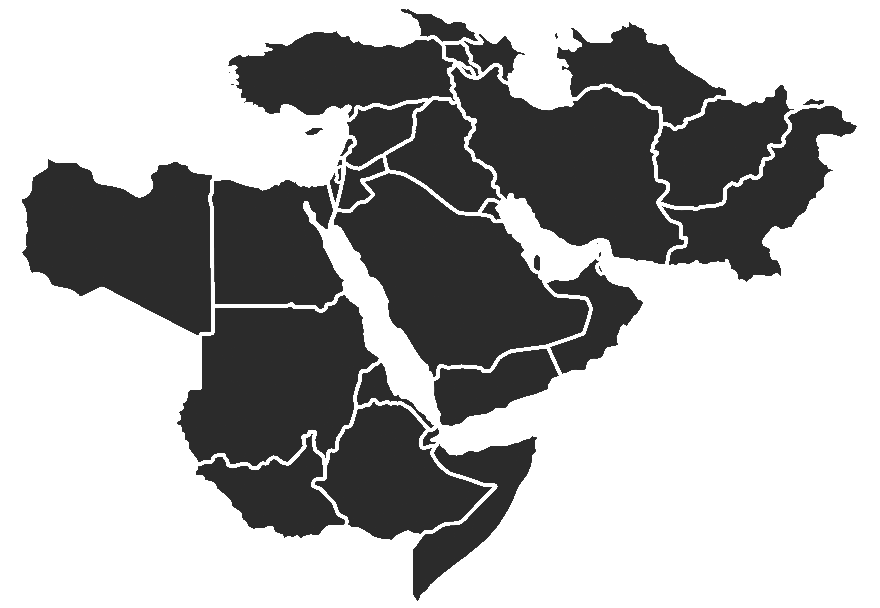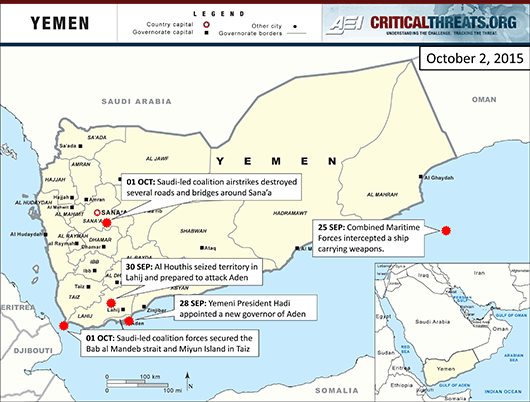The Saudi-led coalition appears to be seeking to regain the momentum against the al Houthis in Yemen, but have not fully consolidated gains. A late September push for renewed talks for a political solution in Yemen seems to have stagnated.
The Saudi-led coalition appears to be phasing a renewed ground offensive in Taiz before resuming preparations to contest the al Houthis for control of Sana’a. Yemeni military spokesman Brig. Gen. Samir Haj reported that coalition forces secured the Bab al Mandeb strait and Miyun Island, which will reduce the al Houthis’ maritime supply lines. There are reports that coalition forces have mobilized toward Taiz and Mokha cities, joining Yemeni military forces that deployed to Taiz city from Aden on September 30. The coalition has repeatedly stated the objective of securing Taiz in order to advance on Sana’a from both the east and the south. Coalition airstrikes targeting a bridge on the al Hudaydah-Sana’a road appear to be part of shaping operations in what may be an attempt to isolate Sana’a. Airstrikes destroyed the bridge on one of the main roads between Ma’rib and Sana’a, and another bridge on one of the western egresses from Sana’a.
The U.S. 5th Fleet confirmed that the multinational Combined Maritime Forces intercepted a ship smuggling weapons southeast of Salalah, Oman. The U.S. Navy reported on September 30 that the dhow’s crew and port of origin were Iranian, which indicates the destination for the weapons, which included anti-tank missiles believed to be of Russian and Iranian origin, was probably Yemen. The crew claimed they were en route to Somalia. Saudi Foreign Minister Adel al Jubeir announced on September 29 that Saudi Arabia had intercepted an Iranian ship delivering arms to the al Houthis. The Navy’s report contradicted this statement slightly, noting that the country that made the initial interception was not one of the Gulf nations participating in the Saudi-led coalition.
The Saudi-led coalition’s air campaign came under increased scrutiny during the UN General Assembly. The coalition attempted to deflect criticism of its bombing campaign by advertising Saudi humanitarian aid efforts in Yemen. A Dutch draft resolution to the UN, tentatively backed by the U.S., initially called for an international fact-finding mission on human rights abuses in Yemen. A Saudi resolution, which created a national inquiry into the violations, passed unanimously through the UN.
Yemeni President Abdu Rabbu Mansour Hadi’s government still faces challenges in southern Yemen, where Hadi lacks popular legitimacy and the al Houthis are mounting a counteroffensive. Hadi tried to reduce tensions between his government and southerners by nominating Yemeni southern resistance leader Aydarus Qasim al Zubaydi as governor of Aden on September 28. Separately, the al Houthis mounted a counteroffensive against Saudi-led coalition positions in southern Yemen on September 30, seizing strategic territory in Taiz and Lahij and transferring several military vehicles into Lahij, potentially staging for an attack on Aden. Pro-al Houthi forces also fired a ballistic missile at the Salah al Din military base in Aden on October 1. The al Houthis’ ability to contest coalition control in Lahij will prevent the coalition and Hadi’s government from consolidating positions in southern Yemen.
The protracted conflict in Yemen will continue to distract from the fight against al Qaeda in the Arabian Peninsula and the Islamic State of Iraq and al Sham in Yemen. Neither side in Yemen appears to be willing to make the necessary concessions to reach a political agreement.
Emily Estelle contributed to the research for this piece.
← PREVIOUS |
NEXT → |

